Tender, tasty, and oh-so-versatile, it’s no wonder why turkey is a kitchen staple. If this delicious roasted turkey wings recipe hits the spot, I have so many other turkey recipes guaranteed to delight your tastebuds—without having to cook the entire turkey! My Baked Turkey Tenderloin is an elegant, herby main worthy of a food magazine spread, while my Turkey Drumsticks packs all the juicy, savory goodness of the whole bird in perfectly portioned pieces.

Why Does This Recipe Work?
If you’ve ever tried baking turkey wings in the oven like you would cook chicken wings, chances are, you’ve ended up with dry, flavorless meat. However, I’ve designed this recipe to give you juicy turkey wings packed with savory flavor every time you prepare it.
During our recipe testing, we learned two important lessons:
- Gentle heat is the best: You probably already know this, but turkey meat tends to be tougher than chicken, requiring a different cooking method. While you can technically roast turkey wings in the oven like you would with chicken wings (and they will look nice and crispy), the meat ends up being tough and dry.
In our quest for a solution, we came across a Southern turkey wings recipe. In this method, the wings were cooked low and slow, with a bit of extra liquid added to the baking pan. Following in the food steps of the Southerners, we were able to achieve turkey meat that was juicy and tender on the inside, complemented by a beautifully browned, crispy exterior. - Start with a cover and then remove it for browning. Another trick we learned was to bake them covered for an hour, followed by an additional thirty minutes uncovered. This initial covered phase helped wings retain moisture, ensuring a juicy interior, while the subsequent uncovered phase allowed them to develop a crispy exterior.
Ingredients
Tired of bland, flavorless wings? This recipe combines fresh, rich, and flavorful ingredients to make the best seasoning for turkey wings—a savory combination of fresh herbs and spices no one can resist. Below is everything you’ll need:
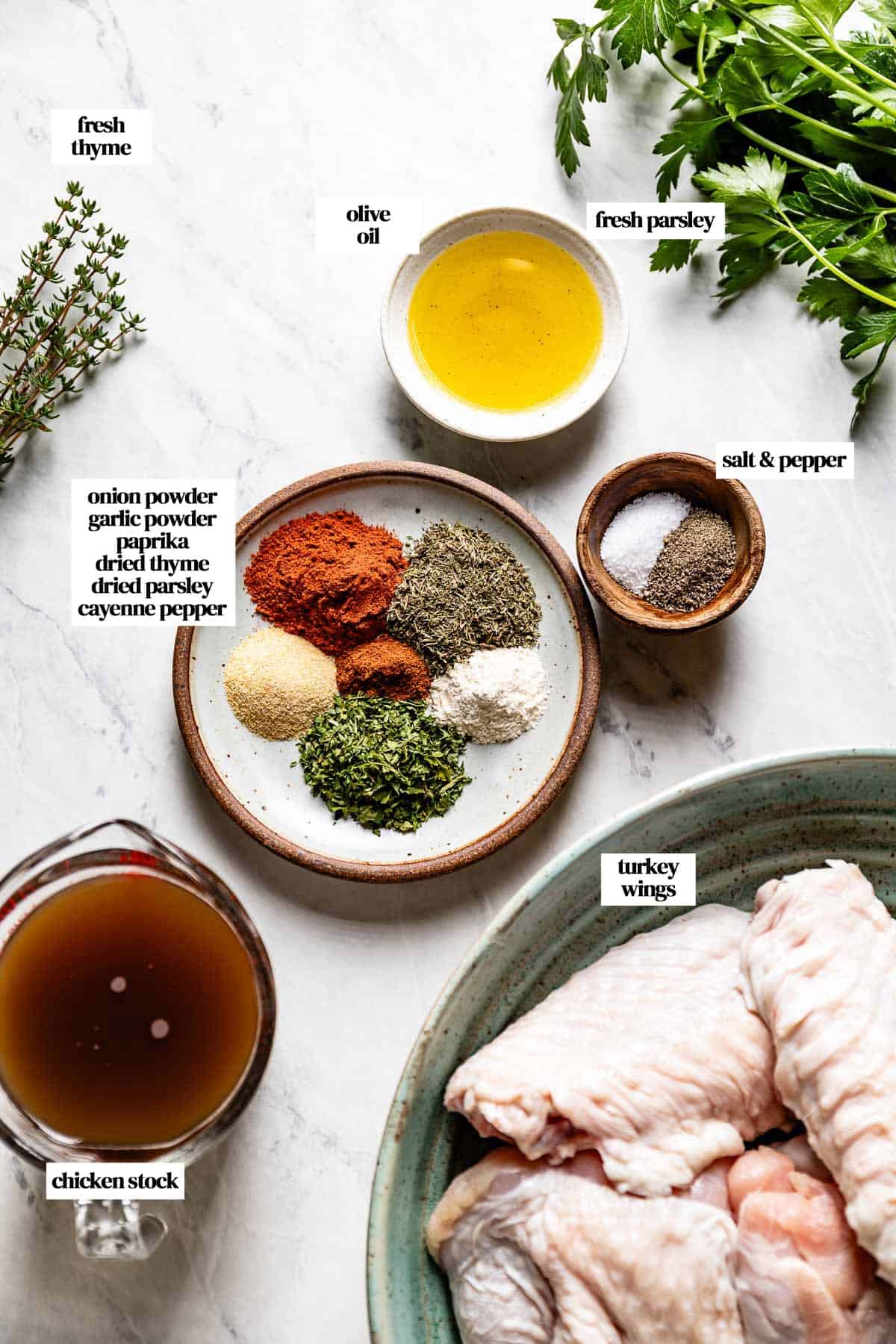
- Fresh turkey wings: Whole turkey wings have three distinct parts to them: the drumette, the wingette (also known as the “flat”), and the tip or “flapper.” The turkey wing tips are small and have little meat, so they’re prone to burning. Therefore, I recommend removing the tips and saving them to make turkey stock. While you can cook turkey wings as a whole, I prefer cutting them before roasting. If you’d like some help with this step, you can buy your turkey wings whole, cut them yourself, or ask the local butcher at your grocery store to cut them for you. If you prefer using frozen turkey wings, be sure to fully thaw them first. No matter how you buy your turkey wings, though, just be sure to avoid smoked turkey wings (which come pre-cooked), as they’ll dry out while making this recipe.
- Oil: I prefer olive oil to give my slow-roasted turkey wings their iconic crispy exteriors and tender, succulent insides. However, another mild-flavored oil, such as avocado oil, would also work.
- Turkey wings seasonings: In my opinion, the best seasoning for turkey wings comes with a savory mix of pantry-ready ingredients, including onion powder, garlic powder, paprika, Kosher salt, and black pepper. To add extra-fresh overtones to your seasoning, I also recommend adding dried thyme and parsley to the mixture. You may also add cayenne pepper or red pepper flakes for an extra kick of spice, though this ingredient is optional.
- Stock: Use either chicken broth or turkey stock to give your baked turkey wings extra succulent meat.
- Fresh herbs: Though this garnish is optional, fresh herbs—like parsley, thyme, and rosemary—will transform your tender baked turkey wings into a gourmet meal, infusing each bite with herby, bright flavors.
How to Make It
This oven-baked turkey wings recipe takes only a handful of simple steps, giving you tender, juicy turkey no matter when you prepare it.
- Prepare the oven: Preheat the oven to 300 degrees F.
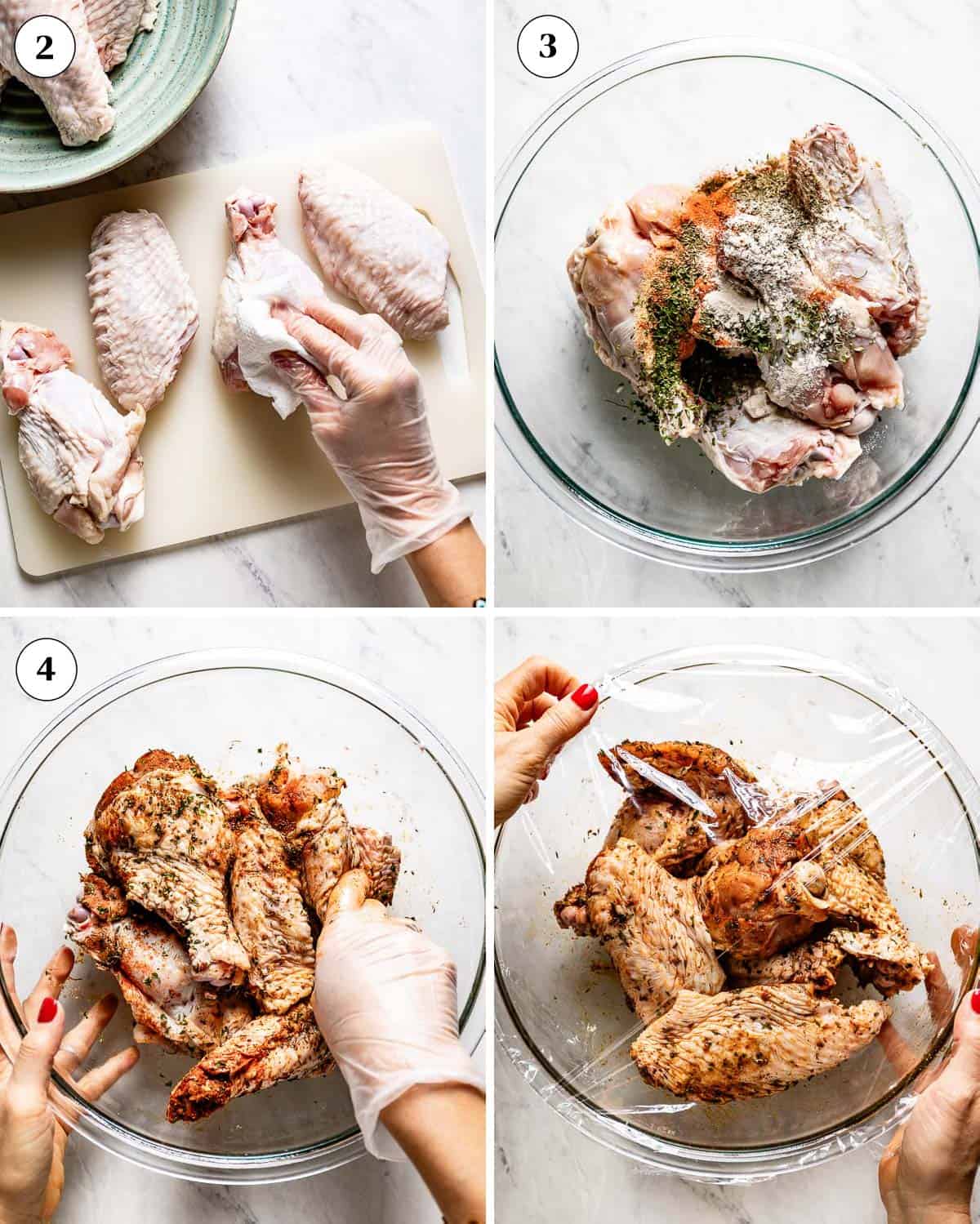
- Dry the meat: Place the turkey wings on a cutting board and use paper towels to pat dry each piece on all sides. Once dry, transfer the wings to a large bowl.
- Season the turkey wings: Drizzle olive oil over the turkey wings and sprinkle them with an even coating of onion powder, garlic powder, paprika, thyme, parsley, cayenne pepper (if using), Kosher salt, and pepper.
- Marinate turkey wings: Toss the ingredients until thoroughly combined. Then, cover the bowl with stretch film and let the meat sit in the turkey wing marinade for a minimum of 30 minutes in the fridge. If possible, I recommend marinating the turkey wings overnight to ensure they soak up as much flavor as possible.
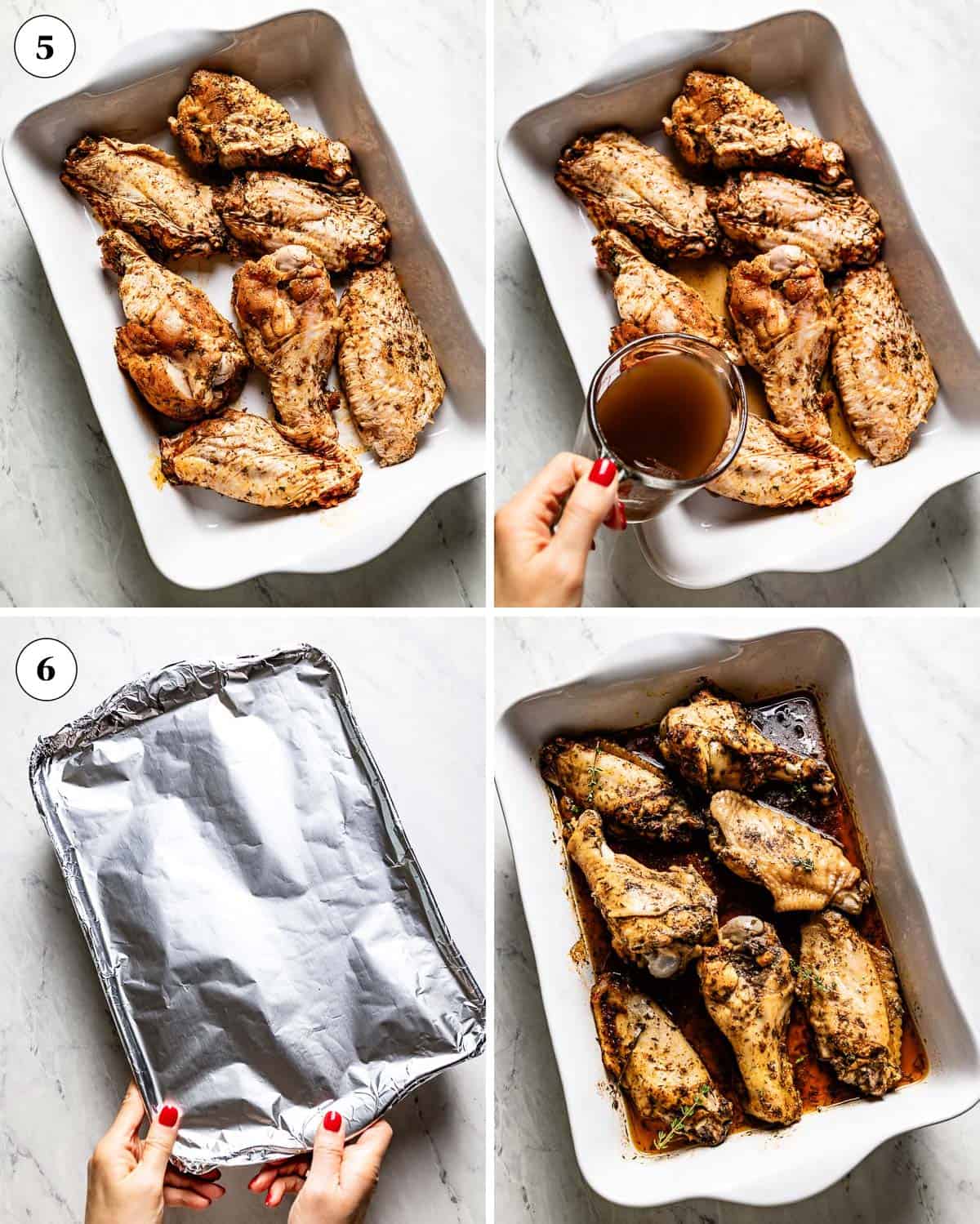
- Add the stock: When ready to bake, place the marinated turkey wings in a Dutch oven or casserole dish and add the stock to the base.
- Roast the turkey wings: Cover the dish with aluminum foil or the lid of your Dutch oven. Then, bake the turkey wings for one hour. After one hour, remove the foil and cook them in the baking dish for another 30 minutes. You may remove your slow-baked turkey wings from the oven when their thickest portions reach an internal temperature of 165 degrees F. However, it is OK to let the meat cook until it reaches a maximum of 180 degrees F.
- Serve: Transfer the roast turkey wings to a serving platter when ready. Drizzle them with the juices in the pan for maximum juiciness and flavor, then garnish the meat with fresh herbs.
How to Make Turkey Wings Crispy?
For extra crispy baked turkey wings, broil them for a few minutes. Here is how I do it:

- Remove the cooked turkey from the pan after baking and transfer the wings to a sheet pan lined with a wire rack.
- Place the meat under the broiler for 1-2 minutes or until the skin crisps up. However, keep a close eye on the turkey to avoid burning, as this meat can go from perfectly juicy to thoroughly dry in very little time.
- Let the broiled turkey wings rest for 5 minutes before serving.
How to Store, Reheat, Freeze, and Thaw?
One taste of these oven-fried turkey wings, and you won’t want to sacrifice a single bite. Storing your turkey wings is a cinch with these pro tips, giving you easy meal prep for days on end.
- Store: After slow-cooking turkey wings in the oven, first cool them to room temperature, and then place them in an airtight container. Store them in the refrigerator for up to 4 days.
- Freeze: Allow the baked turkey flats and drummettes to come to room temperature. Once they’ve cooled, place them in an airtight container, ensuring they are well-covered to prevent freezer burn. These turkey pieces can be stored in the freezer for up to 3 months.
- Thaw: I recommend thawing your frozen turkey overnight in the fridge.
- Reheat: To reheat your turkey wings, place them in a casserole dish with the juices and warm them in a 350-degree Fahrenheit oven for 10-15 minutes or until heated thoroughly.
Recipe Variations
The best-baked turkey wings recipe is one that you can customize according to your personal preference. Below, I’ve included some of my favorite ways to switch up this delectable main to satisfy all your cravings.
- Marinade: Take this easy recipe to the next level; marinate turkey pieces in our turkey tenderloin marinade in the fridge for at least 2 hours or overnight. To make this sweet and savory version, transfer the marinated turkey into a casserole dish that will accommodate all the wings comfortably. Instead of using chicken broth, use one cup of the marinade as the cooking liquid. Follow the recipe instructions as written. During our testing, we found that using a marinade with an acid component (i.e., soy sauce and lemon juice) produced super tender, fall-off-the-bone tender turkey wings.
- Southern-style: Looking for an authentic Southern recipe for turkey wings? To make this fresh, flavorful variation, add hardy vegetables (such as bell peppers and onions) into your cooking liquid. If preferred, you can strain the juices post-cooking, place them in a small saucepan, and reduce them until they thicken to a sauce-like texture. Then, serve your turkey wings and veggies over a bed of rice and drizzle them with the sauce for a five-star meal that tastes straight out of Tennessee.
- Smothered: Preparing smothered baked turkey wings is an easy way to give each bite decadently rich flavors. To make the sauce, use the leftover pan drippings to make turkey gravy and pour it over the freshly baked turkey wings. Alternatively, I’ve also seen examples where people prepare cream of mushroom turkey wings instead of cooking their own gravy. If you prefer that shortcut, warm up the cream of mushroom soup and smother the meat just before serving.
- Cajun seasoning: Give your meat a kick of savory, smoky flavor by baking Cajun turkey wings in the oven. All you need to do is change the seasoning for the turkey wings and use our spicy and bold Blackened Seasoning instead.
- Lemon pepper turkey wings: To add bright, citrusy zest to your baked turkey wings, I recommend swapping out our recommended poultry seasoning mixture for a five-minute Lemon Pepper Seasoning.
What To Serve With Turkey Wings?
It doesn’t matter whether you’re serving up a platter of turkey wings and stuffing for a small holiday gathering or making your favorite comfort foods for Sunday supper. These ideas will fill your table with delectable sides, whether you’re preparing your go-to Healthy Thanksgiving Recipes, Friendsgiving Recipes, or looking for creative ideas for your next Football Food spread.

- Thanksgiving or Friendsgiving: Not a fan of cooking the full bird? Make this easy recipe instead! Serving a menu of turkey wings and Cornbread Dressing with a side of Maple Cranberry Sauce is an automatic hit among guests, especially when paired with my creamy Green Bean Casserole recipe. Or, if you’re looking for a rich, filling side, my Mashed Sweet Potatoes or Rosemary Garlic Mashed Potatoes will fill every fork with the velvety taste of seasoned potatoes.
- Sunday dinners: With this iconic menu, you’ll never run out of turkey wing dinner ideas. All your Sunday supper guests will be satisfied when you pair your wings with cheesy classics like my Healthy Mac and Cheese and Jalapeno Cheddar Cornbread. You can even add a touch of Southern goodness by baking a batch of Sweet Potato Biscuits. Or, for a healthy yet hearty meal, you can serve a spread of baked turkey wings and rice using any of your favorites, from wild rice to brown jasmine rice or even white rice.
- Game day: No game day menu is complete without your go-to dip recipes. Your guests won’t be able to resist dipping their tender turkey meat in creamy, tangy, and light sauces, like my Yogurt Ranch Dip or Blue Cheese Dip.
Expert Tips
It is no secret that slow-baked turkey wings are a great option when trying to serve a lot of people with minimal time in the kitchen. However, there are a few lessons we learned during our recipe testing. Below are our foolproof tips for success:
- The size of the turkey wings matters: There is a direct correlation between the size of the wings and the cooking time. For instance, young/small turkey wings will need less time in the oven than big turkey wings. Therefore, it’s best to buy wings that are similar in size to ensure even cooking. For reference, when testing this recipe, I used four wings totaling about three pounds. Furthermore, I don’t recommend using wing tips, as there is very little meat on them, and they will overcook when following this recipe.
- Marinate longer: If you have the time, let the meat marinate overnight. While a 30-minute marination is effective, letting it sit longer ensures the flavors meld and deepen, yielding more flavorful meat.
- Even layer: Ensure that the drummettes and wingettes are on an even layer in the baking dish. Overcrowding the dish will result in under or over-baked meat.
- Low and slow is the way to go: If you do a quick internet search for this recipe, you will see versions of it where people bake their wings at higher oven temperatures—like 350, 375, or even 400 degrees F. You will also find some recipes that suggest starting with a hot oven and bringing the temperature down. During our testing, we quickly learned that cooking the meat at high temperatures results in dry and tough wings, whereas cooking them at a low temperature—like 300 degrees F.—for a more extended time ensures that the meat doesn’t lose its juices but still cooks through. However, remember that turkey meat can go from perfectly cooked to dry and rubbery in very little time, so I encourage you to watch it closely.
- Cover it well: If you own a Dutch oven with a lid (such as this Le Creuset Braiser – affiliate link), this is the time to use it. The tight-fitting lid of a Dutch oven is ideal for keeping the meat’s juices contained, giving you succulent, moist turkey wings while cooking them in the oven. However, if you don’t have a Dutch oven, just be sure to tightly cover your casserole dish with aluminum foil to ensure it is fully sealed.
- Turkey wing temperature: Technically, your turkey is safe to eat when the thickest part of the wing reaches 165 degrees F. when tested with a digital thermometer. However, please be aware that following the recipe below, your wings could register for up to 180 degrees. But, because we are cooking it low and slow and in a bit of liquid, this is okay. As a matter of fact, it is recommended for the most tender turkey wings. According to science writer Andrew Zimmerman Jones, “As you cook the turkey, muscle fibers contract until they begin to break up at around 180 F. Bonds within the molecules begin to break down, causing proteins to unravel, and the dense muscle meat to become more tender.”
- Experiment with the recipe: Feel free to take this basic recipe and cooking method and experiment with various seasoning blends, serving styles, and favorite side dishes to make it your own.
FAQs
To achieve maximum tenderness, I recommend cooking your turkey wings (covered) at a low temperature, like 300 degrees F., for one hour, followed by thirty minutes uncovered.
When making slow-cooked turkey wings in the oven, I suggest cooking them for one hour, covered, at 300 degrees F. Then, bake the meat for an additional 30 minutes, uncovered, at the same temperature. This cooking time will ensure your meat comes out both tender and crisp without being dry or lacking in flavor.
Your turkey meat will be tough if you cook it in a high-temperature oven for a long time without any liquid.
We found that the best way to tenderize turkey wings is to cook them at a low temperature (I recommend 300 degrees F.) for a long time (about 1 ½ hours.) Cooking the meat covered for the first hour and uncovered for the last half-hour ensures that the meat cooks evenly without drying.
No, I don’t recommend boiling your turkey wings before baking them, as this additional step will strip the meat of their natural juices, leaving them flavorless and rubbery.
When you marinate your turkey wings, let them sit in your seasoning mixture or your favorite turkey marinade for a minimum total time of thirty minutes. However—if possible—I recommend letting your meat marinate overnight in the fridge for extra deep, developed flavors.
Yes, we do recommend covering them for the first half of roasting and then removing the cover for the last 30 minutes to ensure browning on the skin.
The internal temperature for turkey wings should reach a minimum of 165 degrees F. before serving. However, it is okay to cook wings until they reach 180 degrees F. to give them time to crisp up and tenderize.
Turkey wings contain many essential nutrients, such as protein, iron, and calcium, that make them a healthy choice. However, unlike turkey breast, turkey wings are dark meat, which also tends to be high in fat. If you want to reduce your cholesterol intake, I recommend removing the skin from the turkey wings before preparing this recipe.
The number of wings in a pound depends on the size of the turkey, as large turkey wings weigh more than small turkey wings. However, the wings I used in this recipe were of medium size, weighing 0.7 pounds each with the drumette and wingette (three pounds total).
Other Turkey Recipes You Might Also Like
Can’t get enough of this tasty turkey dinner’s rich, tender taste? These other healthy turkey dishes will fill your plate with savory, succulent, and flavorful meals every night of the week.
If you try this Baked Turkey Wings recipe, please take a minute to rate the recipe and leave a comment below. It is a great help to others who are thinking of making the recipe. And if you took some pictures, be sure to share them on Instagram using #foolproofeats so I can share them on my stories.
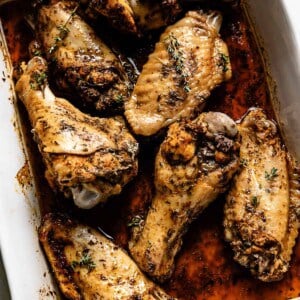
Baked Turkey Wings Recipe
Ingredients
- 3 pounds turkey wings, drumettes and flats separated, and tips removed
- 2 tablespoons olive oil, or avocado oil
- 1 teaspoon onion powder
- 1 teaspoon garlic powder
- 2 teaspoon paprika, or smoked paprika for a smoky flavor
- 1 tablespoon dried thyme
- 1 tablespoon dried parsley
- ¼ teaspoon cayenne pepper, optional
- 1 teaspoon Kosher salt
- 1 teaspoon ground black pepper
- 1 cup chicken stock, or turkey stock
- 1 tablespoon chopped fresh thyme or parsley, as garnish, optional
Instructions
- Preheat the oven to 300 degrees F.
- To prepare the turkey wings, place them on a cutting board and pat dry each piece on all sides using paper towels. Transfer them to a large bowl.
- Drizzle the turkey wings with olive oil and sprinkle them with onion powder, garlic powder, paprika, thyme, parsley, cayenne pepper (if using), Kosher salt, and pepper.
- Toss to combine. Cover the seasoned wings with stretch film and let them marinate for at least 30 minutes in the fridge. You can let them marinate overnight if you have the time.
- When ready to roast, transfer the wings into a casserole dish or a Dutch oven. Add the stock, making sure to not pour it directly over the turkey (we do not want all the spices to wash away.)
- Cover the dish tightly with aluminum foil or the lid of your Dutch oven and bake for 1 hour. After 1 hour, remove the cover and continue cooking for another 30 minutes. During this time, the turkey will reach the ideal 165 degrees F. when a meat thermometer is inserted into the thickest part of a drumette. However, it is okay to let the meat cook after it exceeds the 165 degrees F. mark (up to 180 degrees F.).
- When ready to serve, transfer the turkey wings onto a serving platter, drizzle them with the juices in the pan, and garnish with fresh herbs.
- Alternatively, if you prefer them to have a crispy skin, you can remove the wings from the pan onto a sheet pan lined with a wire rack. Place them under the broiler and roast for a minute or two while keeping a very close eye on them.
Notes
- Yields: This recipe makes 6-7 pieces of wings made up of drumettes and wingettes. Depending on the weight and size of your wings, this amount might change. However, we think it is ideal for 4 servings. The nutritional values below are per serving.
- Wings: You can buy whole wings and cut them yourself (here is a tutorial on how to cut turkey wings into segments) or ask your butcher to cut them for you.
- Size of the wings & cooking time: There is a direct correlation between the size of your wings and the time it will take them to roast thoroughly. The best way to measure doneness is by using a meat thermometer. If the wings register between 165 degrees F and 180 degrees F, they should be safe to eat.
- Marinade: Alternatively, you can marinade turkey pieces in our turkey tenderloin marinade in the fridge for at least 2 hours or overnight. To make this sweet and savory version, transfer the marinated turkey into a baking dish that will accommodate all the pieces comfortably. Instead of using chicken broth, use one cup of the marinade as the cooking liquid. Follow the recipe instructions as written. During our testing, we found that using a marinade with an acid component (i.e., soy sauce and lemon juice) produced super tender, fall-off-the-bone tender turkey wings.
- Low and slow is the way to go: If you do a quick internet search for this recipe, you will see versions of it where wings are baked at higher oven temperatures. You will also find some recipes that suggest starting with a hot oven and bringing the temperature down. During our testing, we quickly learned that cooking the meat at high temperatures results in dry and tough wings. Instead, cooking them at a low temperature—like 300 degrees F.—for a more extended time ensures that the meat doesn’t lose its juices but still cooks through. However, remember that turkey meat can go from perfectly cooked to dry and rubbery in very little time, so I encourage you to watch it closely.
Nutrition
Nutrition information is automatically calculated, so should only be used as an approximation.
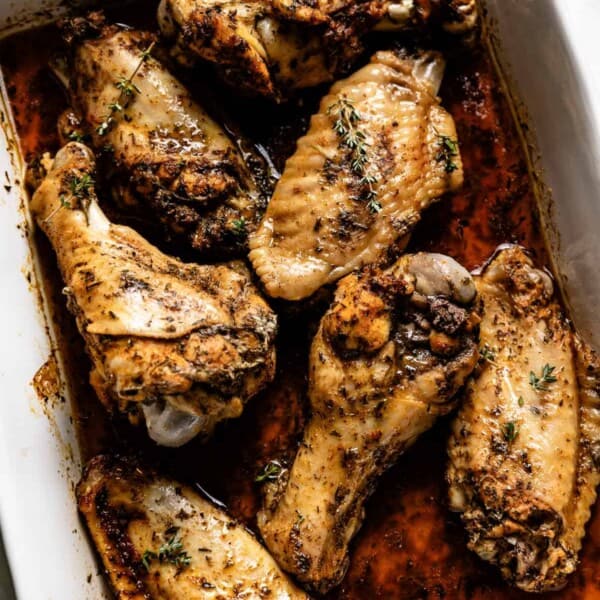

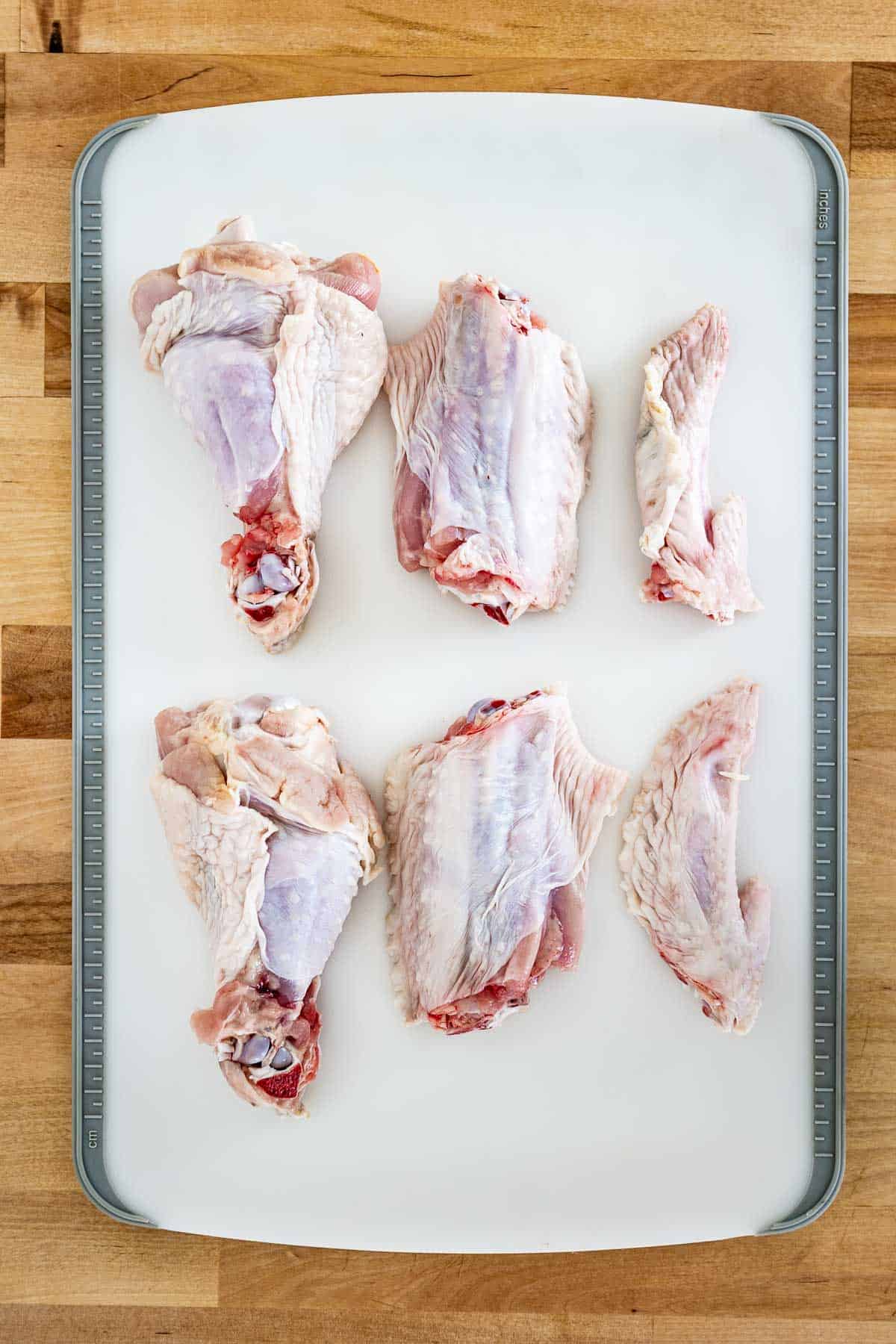


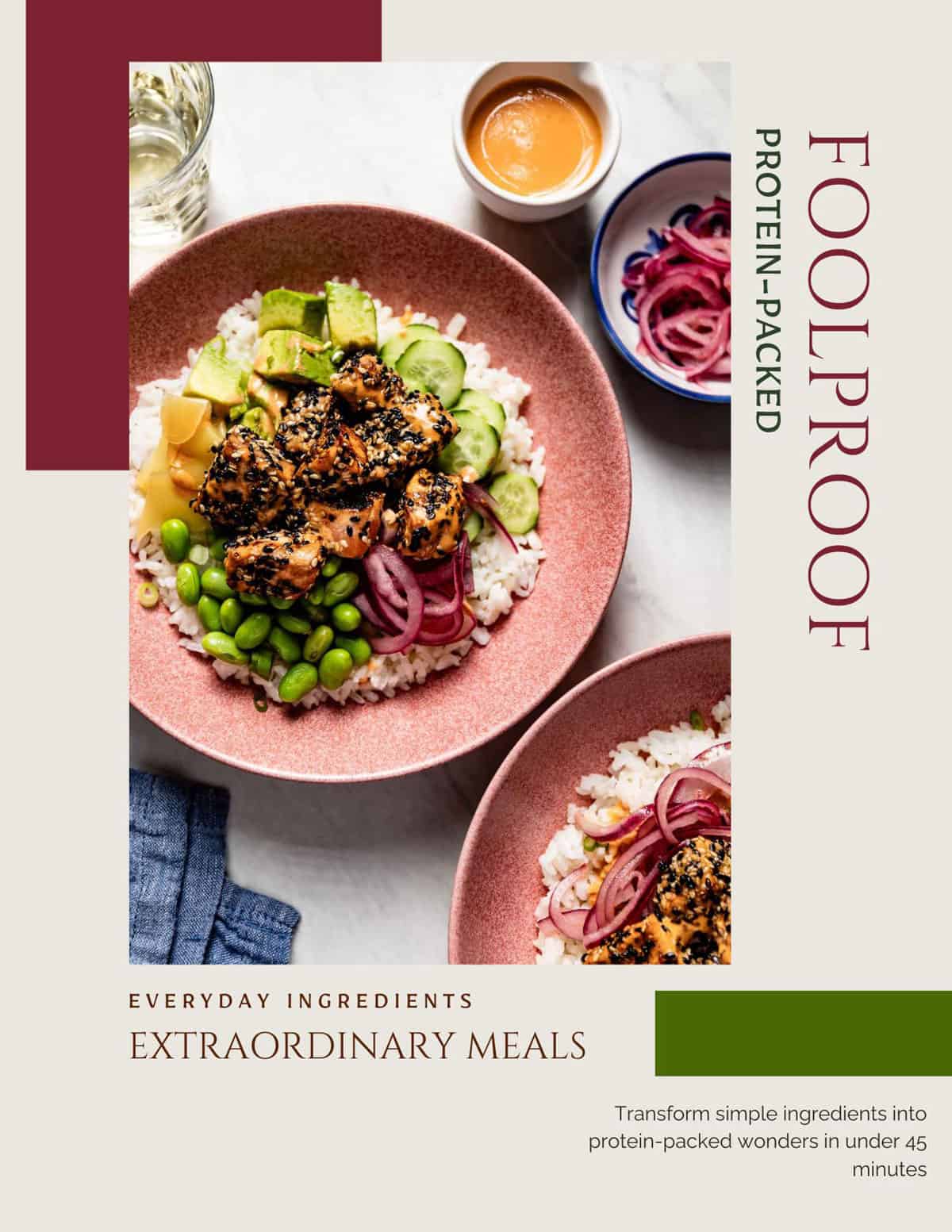









Hi there! I want to make these wings for thanksgiving alongside a holiday stuffed turkey breast I received from the butcher, which I’m supposed to cook at 375 for 50 mins. Ideally I’d make the wings and this at the same time, but the temperature is different. Can I cook the wings a notch higher at 375 and for less time? If so, how long do you think? Thank you so much!
Hello Jen,
I see what you are trying to do, but sadly I would not recommend that. We actually tested this recipe using a high temperature oven and ended up with tough and dry turkey meat. What makes our recipe work is that it cooks the wings in a low heat oven for a long time.
I know that is not convenient for your situation but I would hate for you to end up with less than ideal results.
Hope this helps.
Aysegul